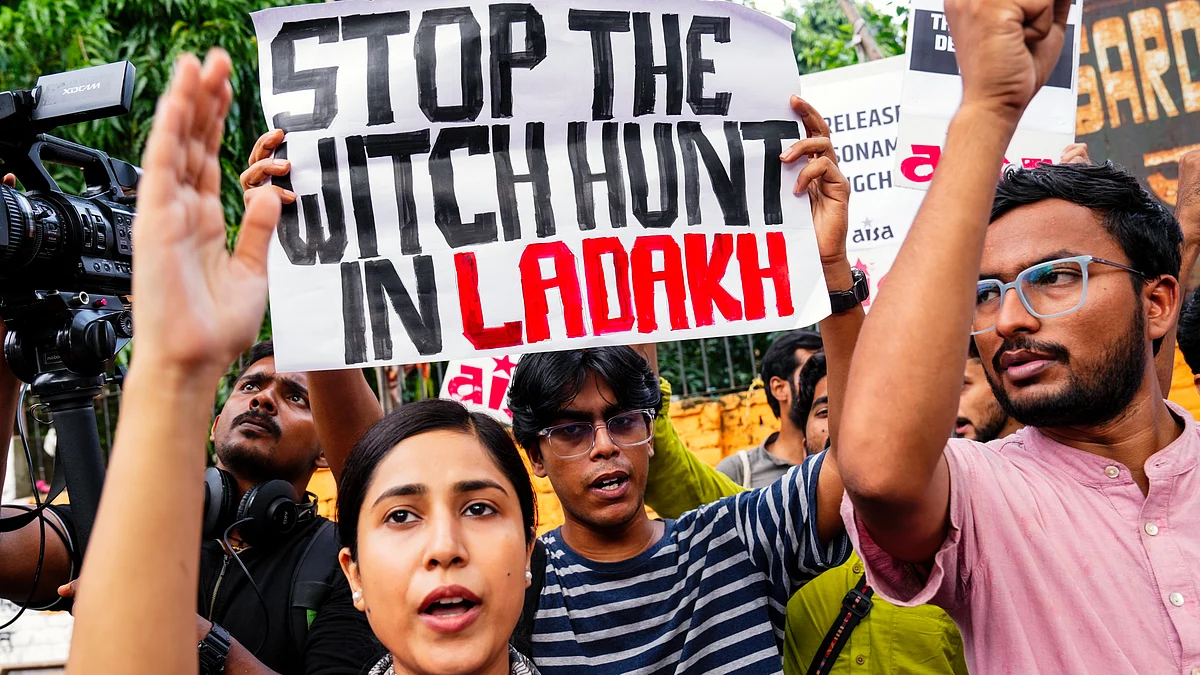Ladakh peaceful, says LG office; Leh Apex Body calls it an illusion
Despite official claims of calm, Ladakh remains under curbs, detentions and an internet blackout

The Ladakh administration’s insistence that the Union Territory has “returned to normalcy” has come under sharp criticism, with residents and leaders describing the claim as a façade masking continuing restrictions, detentions, and communication blockades. Despite official assertions that schools, offices and markets are open, the reality on the ground appears far from normal.
“Normalcy cannot return through intimidation... What appears normal on the surface is just an illusion,” warned Leh Apex Body (LAB) co-chairman Chering Dorjay, exposing the gulf between the administration’s narrative and people’s lived experience. Addressing a press conference, Dorjay alleged that “mass arrests” were still underway, deepening the atmosphere of fear and mistrust.
The violence of 24 September, when Leh erupted in protests led jointly by the LAB and Kargil Democratic Alliance (KDA) demanding statehood and inclusion under the Sixth Schedule, continues to cast a shadow. Four people lost their lives and scores were injured, forcing authorities to impose curfew and suspend mobile internet across the Union Territory.
Although officials claim gradual easing of restrictions — with schools up to Class 8 reopening from 3 October — the administration’s tight control remains evident. Prohibitory orders banning gatherings of five or more people are still in force, while internet services are yet to be restored, leaving citizens cut off from essential communication and information.
“Lt Governor today (Monday) chaired a high-level meeting to review the security situation in Ladakh. The UT remains peaceful, with schools, offices, and markets reopened,” the LG office declared on X, projecting an image of calm. Yet that calm, critics argue, is being maintained not through reconciliation but through repression.
L-G Kavinder Gupta, who has held daily security review meetings since the unrest, urged officials to “remain vigilant and focus on peace and development”. But the peace he describes seems administrative rather than organic, enforced by surveillance, detentions, and silence.
At his press briefing, Dorjay rebutted the government’s claims directly. “Nothing is normal as the internet continues to remain suspended and mass arrests are also going on,” he said, flanked by LAB members. He called for the immediate lifting of restrictions and the release of all detainees, arguing that such steps are essential to restore public trust. “Such measures are imperative to bring Ladakh back to normal.”
Dorjay accused the government of “harassing numberdars (village heads)” who had simply informed villagers about the LAB’s hunger strike from 10 to 24 September — an agitation that sought constitutional safeguards and political rights for Ladakh. “They (numberdars) are an important part of our culture and are being harassed without any justification. We condemn such action and consider it an attack on our culture,” he said, warning the administration to desist from such conduct.
He added that the detention of community leaders would “not help restore peace,” insisting that “normalcy cannot return through intimidation.” Dorjay reiterated that “the questioning of numberdars is unjust. They did not instigate protests but only performed their duty of communicating with villagers”.
While the LAB reaffirmed its commitment to a “peaceful struggle”, the government’s actions — continuing curbs, selective arrests and prolonged internet shutdown — appear to be eroding confidence rather than rebuilding it.
Also Read: Why a loyalty test for Ladakh?
On Sunday, the L-G once again assured that his administration was “fully committed to restoring complete normalcy and easing public convenience at the earliest.” But assurances ring hollow when accompanied by an ongoing clampdown.
Chief secretary Pawan Kotwal echoed similar sentiments, blaming “vested interests” for the 24 September violence and claiming that the government “stands committed to meet the aspirations of the people of Ladakh” through dialogue. Yet, even as he spoke of engagement, LAB and KDA leaders refused to attend the scheduled meeting with the Centre on 6 October until a judicial probe is ordered into the deaths of four protesters and all detainees — including climate activist Sonam Wangchuk — are released.
Kotwal said 30 of the 70 detained youths had been freed while the rest remained in judicial custody “to be released as per court orders.” His assurance that “youngsters are not put to any hardship and no misguided innocent person is implicated” contrasts starkly with the LAB’s claim of “mass arrests” and arbitrary harassment.
For many in Ladakh, the government’s portrayal of peace looks like control dressed up as calm. As long as communication blackouts, detentions and prohibitory orders continue, the administration’s talk of “normalcy” risks sounding less like governance and more like denial.
With PTI inputs
Follow us on: Facebook, Twitter, Google News, Instagram
Join our official telegram channel (@nationalherald) and stay updated with the latest headlines
